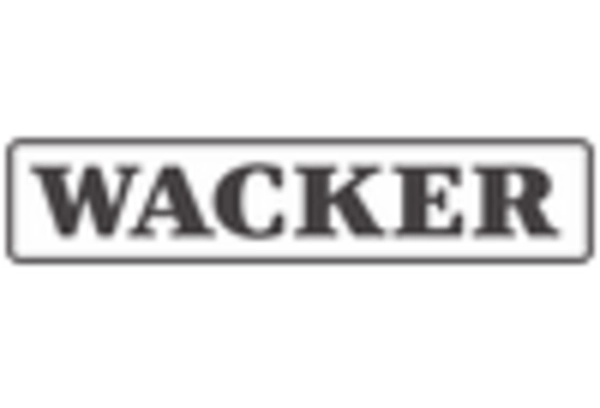Growth in Construction Activities
The construction industry is witnessing robust growth, which is significantly impacting The Global Silicones Industry. Silicones are extensively used in construction applications, including sealants, adhesives, and insulation materials, due to their superior properties such as weather resistance and durability. In recent years, the construction sector has expanded, with a projected growth rate of 4.5% annually through 2025. This expansion is driven by urbanization, infrastructure development, and the increasing focus on sustainable building practices. As a result, the demand for silicone products in construction is expected to rise, as builders and contractors seek materials that enhance energy efficiency and reduce environmental impact. The integration of silicones in green building initiatives further underscores their importance in modern construction.
Rising Demand in Automotive Sector
The automotive sector is experiencing a notable surge in demand for silicone materials, driven by the need for lightweight, durable, and high-performance components. Silicones are increasingly utilized in various applications, including sealants, adhesives, and coatings, which enhance vehicle performance and longevity. In 2023, the automotive industry accounted for approximately 25% of the total consumption of silicones, reflecting a growing trend towards the integration of advanced materials in vehicle manufacturing. This shift is likely to continue, as manufacturers seek to improve fuel efficiency and reduce emissions, thereby propelling The Global Silicones Industry forward. Furthermore, the increasing adoption of electric vehicles is expected to further amplify the demand for silicone-based products, as these vehicles require specialized materials to meet their unique performance requirements.
Expansion of Electronics and Consumer Goods
The electronics and consumer goods sectors are experiencing rapid growth, which is positively influencing The Global Silicones Industry. Silicones are widely used in the production of electronic components, such as insulators, encapsulants, and thermal interface materials, due to their excellent electrical properties and thermal stability. In 2023, the electronics sector accounted for around 20% of the total silicone market share, driven by the increasing demand for consumer electronics and smart devices. This trend is expected to continue, as technological advancements lead to the development of more sophisticated electronic products. Additionally, the growing trend of smart homes and IoT devices is likely to further boost the demand for silicone materials, as manufacturers seek reliable and high-performance solutions for their products.
Increasing Focus on Healthcare Applications
The healthcare sector is increasingly recognizing the value of silicone materials, which are essential in various medical applications. Silicones are utilized in medical devices, implants, and drug delivery systems due to their biocompatibility and flexibility. The Global Silicones Industry is projected to see substantial growth in this segment, as the demand for advanced medical technologies continues to rise. In 2023, the healthcare application accounted for approximately 15% of the total silicone consumption, reflecting a growing trend towards the use of high-quality materials in medical applications. As the global population ages and the prevalence of chronic diseases increases, the need for innovative healthcare solutions is likely to drive further demand for silicone products, thereby enhancing the market's growth prospects.
Technological Innovations in Silicone Production
Technological advancements in silicone production processes are playing a crucial role in shaping The Global Silicones Industry. Innovations such as the development of new synthesis methods and the enhancement of existing manufacturing techniques are leading to improved product quality and reduced production costs. For instance, the introduction of eco-friendly production methods has not only minimized environmental impact but also catered to the increasing demand for sustainable materials. In 2023, the silicone production capacity increased by approximately 10%, driven by these technological improvements. This growth is expected to continue, as manufacturers invest in research and development to create high-performance silicone products that meet diverse industry needs. Consequently, the market is likely to benefit from a wider range of applications and enhanced product offerings.















Leave a Comment